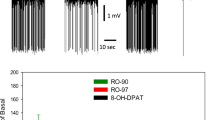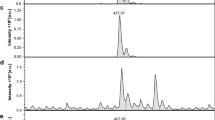Abstract
THE levels and turnover of 5-hydroxytryptamine (5-HT), noradrenaline (NA) and dopamine (DA) suggest that monoaminergic neurones (particularly serotoninergic ones) and their postsynaptic receptors are the main targets of LSD action in man and animals1–4. Because this evidence still seems inconclusive4, we have compared here the effects of LSD with those of lisuride on the biochemistry of brain amines in the rat. Lisuride is an ergot derivative recently introduced for the treatment of migraine, and in oral doses of up to 600 µg, is without hallucinogenic properties in man5. This lack of psychotomimetic effect is unlikely to be due to poor bioavailability after oral administration, because, at least in the rat, oral lisuride was even more effective than after intraperitoneal injection in altering monoamine turnover6. In addition, we have studied the effects of LSD and lisuride after intracerebral injection into the raphe nuclei. The present findings do not support the hypothesis that the hallucinogenic effect of LSD is reflected by variations in the level and turnover of the brain amines. In particular, a stimulation of 5-HT autoreceptors is also evident after the non-hallucinogenic lisuride.
This is a preview of subscription content, access via your institution
Access options
Subscribe to this journal
Receive 51 print issues and online access
$199.00 per year
only $3.90 per issue
Buy this article
- Purchase on Springer Link
- Instant access to full article PDF
Prices may be subject to local taxes which are calculated during checkout
Similar content being viewed by others
References
Smith, R. C., Boggan, W. O. & Freedman, D. X. Psychopharmacologia 42, 271–276 (1975).
Freedman, D. X., Gottlieb, R. & Lovell, R. A. Biochem. Pharmac. 29, 1181–1188 (1970).
Andén, N-E., Corrodi, H., Fuxe, K. & Hökfelt, T. Br. J. Pharmac. 34, 1–7 (1968).
Brawley, P. & Duffield, J. C. Pharmac. Rev. 24, 31–66 (1972).
Herrmann, W. M. et al. Headache 17, 54–60 (1977).
Keller, H. H. et al. J. Pharmac. exp. Ther. (in the press).
Kebabian, S. W., Petzold, G. L. & Greengard, P. Proc. natn. Acad. Sci. U.S.A. 69, 2145–2149 (1972).
Blumberg, J. B., Taylor, R. E. & Sulser, F. J. Pharm. Pharmac. 27, 125–128 (1975).
Kehr, W. Eur. J. Pharmac. 41, 261–273 (1977).
Da Prada, M. et al. Brain Res. 94, 67–73 (1975).
Keller, H. H., Burkard, W. P. & Da Prada, M. Experientia 33, 806 (1977).
Keller, H. H. et al. Symp. Dopamine, Southampton (Raven, New York, in the press).
Pieri, M., Schaffner, R. & Haefely, W. Experientia 33, 808 (1977).
Pieri, M. et al. Archs int. Pharmacodyn. Ther. 217, 118–130 (1975).
Da Prada, M. et al. Ann. N. Y. Acad. Sci. (in the press).
Pieri, L., Pieri, M. & Haefely, W. Nature 252, 586–588 (1974).
Aghajanian, G. K. & Haigler, H. J. in Advances in Biochemistry and Psychopharmacology (eds Costa, E., Gessa, G. L. & Sandler, M.) 167–177 (Raven, New York, 1975).
Monachon, M. A., Burkard, W. P., Jalfre, M. & Haefely, W. Archs Pharmac. 274, 192–197 (1972).
Da Prada, M., Bonetti, E. P. & Keller, H. H. Neurosci. Lett. 6, 349–353 (1977).
Diab, I. M., Freedman, D. X. & Roth, L. J. Science 173, 1022–1024 (1971).
Bennett, J. L. & Aghajanian, G. K. J. Pharm. Pharmac. 28, 516–518 (1976).
Schmidt, M. J. & Hill, L. E. Life Sci. 20, 789–798 (1977).
Logan, W. J. in Advances in Neurology (ed. Friendlander, W. J.) 13, 47–72 (Raven, New York, 1975).
Aghajanian, G. K. & Haigler, H. J. Psychopharmac. Commun. 6, 619–629 (1975).
Aghajanian, G. K. Neuropharmacology 15, 521–528 (1976).
Whitaker, P. M. & Seeman, P. J. Pharm. Pharmac. 29, 506–507 (1977).
Bennett, J. P. & Snyder, S. H. Molec. Pharmac. 12, 373–389 (1976).
Snyder, S. H., Faillace, L. & Hollister, L. Science 158, 669–670 (1967).
Lloyd, D. Appl. Ther. 12, 19–25 (1970).
Andén, N-E., Roos, B. E. & Werdinius, B. Life Sci. 3, 149–158 (1964).
König, J. F. R. & Klippel, R. A. The Rat Brain: a Stereotaxic Atlas of the Forebrain and Lower Parts of the Brain Stem (Williams & Wilkins, Baltimore, 1963).
Author information
Authors and Affiliations
Rights and permissions
About this article
Cite this article
PIERI, L., KELLER, H., BURKARD, W. et al. Effects of lisuride and LSD on cerebral monoamine systems and hallucinosis. Nature 272, 278–280 (1978). https://doi.org/10.1038/272278a0
Received:
Accepted:
Issue Date:
DOI: https://doi.org/10.1038/272278a0
This article is cited by
-
Contrasting effects of DOI and lisuride on impulsive decision-making in delay discounting task
Psychopharmacology (2022)
-
Classical dopamine agonists
Journal of Neural Transmission (2019)
-
Visual hallucinosis: The major clinical determinant of distorted chromatic contour perception in Parkinson's disease
Journal of Neural Transmission (1996)
-
LSD and structural analogs: pharmacological evaluation at D1 dopamine receptors
Psychopharmacology (1995)
-
Selective D-1 dopamine receptor agonist treatment of parkinson's disease
Journal of Neural Transmission (1987)
Comments
By submitting a comment you agree to abide by our Terms and Community Guidelines. If you find something abusive or that does not comply with our terms or guidelines please flag it as inappropriate.



